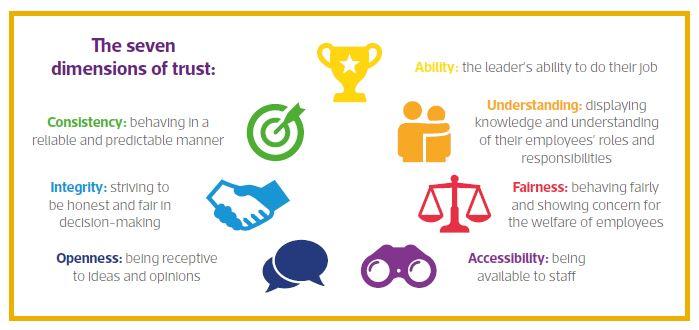Trust in Leaders Research 2018
In 2009 The Institute of Leadership & Management undertook research to develop and validate the Index of Leadership Trust (ILT). The ILT provided sophisticated measurements to analyse six core dimensions of trust. The research was repeated during 2010 and 2011, providing a measure of the trajectory of trust in line managers and CEOs over a 3-year period. The data collected enabled us to calculate an overall trust score and a more detailed breakdown of six core dimensions of trust; ability, understanding, fairness, openness, integrity and consistency.
Previously we found that there was a moderate level of trust in organisations but there was scope
for improvement; CEOs were less trusted than direct line managers (although the gap between them was closing towards 2011), and the third sector consistently outperformed the private sector, which outperformed the public sector. In 2009 and 2010 female CEOs were more trusted than male CEOs, a gap that narrowed in 2011.
With trust being a recurring issue that is ever present in the news headlines, The Institute decided to revisit this topic and undertake fresh research to provide useful insights into the current perceptions of the trustworthiness of today’s organisations and their leaders. In this new research, we continued to investigate the original six dimensions of trust and have added ‘accessibility’.

Research Highlights
We measured seven dimensions of trust, establishing a trust score out of 100. Our key findings include:
- Line managers are more trusted than CEOs
- Levels of trust in line managers have remained stable since 2011
- Levels of trust in CEOs has decreased since 2011
- CEOs perform least well in the dimension of trust that focuses on understanding the roles of their employees
- Female leaders are more trusted than male leaders, both at the level of CEO and the level of line manager
- CEOs are more trusted in smaller organisations than in larger organisations
- Line managers are most trusted in the third sector compared to line managers in private and public sectors
- Public sector employees have the lowest levels of trust in their CEOs
- Newer employees trust CEOs and line managers more than those who have been in their roles for longer periods of time
- Younger employees are more trusting than older employees
- First-time managers are the most trusting of their line managers
- Senior leadership team members have greater trust in CEOs compared to other levels
- Respondents in Wales trust their line managers less than respondents in other regions of the UK
Recommendations
Ask them
We are often told that employees suffer from fatigue, especially when it comes to surveys, but if you want to raise trust in the organisation ask people what might look like. What are the sorts of actions
that managers need to take to be more trusted.
Safeguard the future
Leaders and managers at every level need to create an environment where they trusted to make the right decisions. In these somewhat turbulent geopolitical times building greater levels of trust offers a greater sense of confidence that, whatever the impact of external events, there is a willingness to face them together.
Work at relationships
The lack of understanding on the part of CEOs of the contributions individuals make, whilst understandable, obviously causes concern. There is no substitute for being interested in what people do, asking them and listening to the responses. Trust is relational and, as with any other, effort needs to be put into that relationship.
A united front
Although female managers overall scored slightly higher than their male counterparts, all face similar challenges in building trust. An honest analysis of the gender composition of senior teams, an articulated and clearly shared commitment to action would help improve levels of trust for all senior managers.
Appreciate the demands of line management
Line managers are more trusted across all the dimensions of trust. This undoubtedly takes effort and is a work in progress. Individuals in line management positions need to persist in working on their relationships, engaging with and supporting their staff.
Don’t forget the long servers
As with new customers, it’s often the ‘new’ that gets the attention; there is often a focus on connecting with the newest employees through induction programmes and on-boarding activities. Consider how this level of interest and engagement can be extended to longer standing employees.
Development for everyone
Although cynicism seems to increase with age, longer working lives mean that more effort is needed to engage and involve older employees who demonstrate declining levels of trust. This group are often denied training and development opportunities but in making such opportunities available could revitalise the relationship.
Download your copy below.
Trust in Leaders 2018.pdf4.85MB

